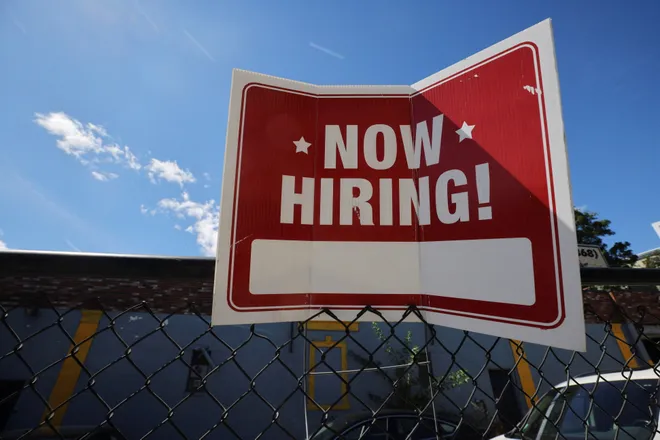Blowout September jobs data points to solid economy and slower Fed rate cuts, analysts say
(This story was updated to add new information.)
America's job market roared back in September as U.S. employers adding 254,000 jobs, according to the Bureau of Labor Statistics.
The number was higher than the average monthly gain of 203,000 over the previous 12 months, according the bureau, and the strongest reading since March. Food and drink industries, health care, government, social assistance and construction led the job gains, which blew past economists' average forecast for 140,000 new jobs and exceeded the upwardly revised August tally of 159,000 new positions.
The unemployment rate also unexpectedly dipped to 4.1% from August's 4.2%.
The strong report put to rest ideas the Federal Reserve may continue aggressively lowering rates to keep the labor market afloat after a sluggish summer of hiring, economists said. The Fed lowered its benchmark fed funds rate last month for the first time in more than four years by a half percentage point, or 50 basis points, to a range of 4.75% to 5% from a 23-year high of 5.25% to 5.5%. It also penciled in shaving another half point by year-end.
Capitalize on high interest rates: Best current CD rates
"Don’t even talk about a 50-basis point cut in November; it’s not on the table," said Tim McDonough, Key Wealth senior portfolio manager. "Blowout numbers for September jobs data ... (are) further evidence that the economy is humming along stronger than expected.”
What industries were hiring in September?
Here are some job categories that saw some of the biggest employment gains in September:
- Food services and drinking establishments: 69,400 jobs added
- Social assistance: 26,500 jobs added
- Construction: 25,000 jobs added
- Local government: 16,000 jobs added
- Retail trade: 15,600 jobs added
- Home health care services: 12,700 jobs added
- Hospitals: 11,500 jobs added
A few industries that shed jobs in September:
- Temporary help services: 13,800 jobs lost
- Warehousing and storage: 11,000 jobs lost
- Transportation equipment manufacturing: 5,200 jobs lost

Other encouraging details
Here are a few of the more encouraging data points from the robust employment report for September:
- Average hourly earnings rose by 0.4% to $35.36 in September, which works out to an annual increase of 4%. Both figures exceeded estimates from economic forecasters.
- Restaurants and bars had a great month. The hospitality industry added 69,000 jobs in September, sweeping well past the average monthly gain of 14,000 jobs in the prior 12 months.
- The unemployment rate for Black workers dipped to 5.7% in September, down from 6.1% in August. And the jobless rate for Hispanic workers dipped to 5.1% in September from 5.5% in August.
- On the downside, the average workweek edged down by 0.1 hour in September to 34.2 hours, and the percentage of people with more than one job increased in September to 5.3% from 5.0% the month before.
How does the jobs report change the Fed's calculus?
Most economists now expect the Fed to slow the pace of rate cuts, trimming a quarter point instead of slicing off another half point when it meets again Nov. 6-7.
"The underlying health of the labor market remains healthier than initially thought, with private job creation still strong," said John Choong, head of equities and markets at Investors Edge. "The Fed will be in no rush to cut either, as the unemployment rate is still relatively low and is still quite some way off the Fed's projections of 4.4-4.5%."
Shruti Mishra, Bank of America US economist, said, "The gangbusters September employment report led us to change our call for the November Fed meeting from a 50-basis-point cut to 25 basis points."
A few even questioned if the Fed would cut at all in November.
"Unemployment (rate) going down to 4.1% might bring the word 'pause' back into the Fed’s vocabulary," McDonough said.

US stock markets rally
The broad S&P 500 index, blue-chip Dow and tech-heavy Nasdaq indexes all rallied Friday on the strong jobs report, which was just enough to wipe out losses from earlier in the week on nervousness over Middle East tensions and port strikes.
The S&P 500 rose 0.9% to 5,751.07, while the Nasdaq composite jumped 1.22% to 18,137.85. The Dow Jones Industrial Average added 341.16 points, or 0.81%, to close at a record high of 42,352.75.
Many market strategists are optimistic for more gains.
"What we have now is an economy that is expanding, a job market which is solid, if not strong, and a Federal Reserve that has not only stopped raising rates but is actually cutting them," said Chris Zaccarelli, chief investment officer at Independent Advisor Alliance. "This is an excellent backdrop for owning equities."
Seasonal jobs begin:Amazon hiring 250,000 seasonal workers before holiday season: What to know about roles, pay
Will inflation return?
Inflation has been trending lower, which allowed the Fed to feel confident in pivoting to focus on maximum employment, the other half of its dual mandate. It slashed rates aggressively last month to help keep the job market strong.
Some economists worry the Fed may have called victory over inflation too soon.
On an annual basis, average hourly earnings ticked up to 4.0%, the strongest since May and “above the recent pace of inflation, helping to restore buying power lost when prices were soaring," said Mark Hamrick, senior economic analyst at Bankrate.
Though that's good for workers, some worry higher wages and Middle East tensions could reignite inflation. Oil prices have spiked this week by the most in nearly two years on fears escalating strikes between Israel, Lebanon and Iran could disrupt oil supply.
"With oil prices rising because of Middle East tensions ratcheting up, and average hourly earnings rising, the Fed may worry about inflation rearing its ugly head," said Gina Bolvin, president of Bolvin Wealth Management Group. "We may be back to them focusing on a 50/50 dual mandate" of stable prices and maximum employment.
Steve Wyett, chief investment strategist at BOK Financial, said strong average hourly earnings, coupled with "the eye-popping port workers wage agreement (for a 62% pay increase over six years), reminds us that inflation may yet be an issue for the Fed. There are not enough port workers as compared to the size of the labor force to have a direct impact on overall wage levels, but it appears the progress to the Fed’s 2% target might remain slow."
Contributing: Daniel de Visé
Medora Lee is a money, markets, and personal finance reporter at USA TODAY. You can reach her at mjlee@usatoday.com and subscribe to our free Daily Money newsletter for personal finance tips and business news every Monday through Friday morning.
Disclaimer: The copyright of this article belongs to the original author. Reposting this article is solely for the purpose of information dissemination and does not constitute any investment advice. If there is any infringement, please contact us immediately. We will make corrections or deletions as necessary. Thank you.







